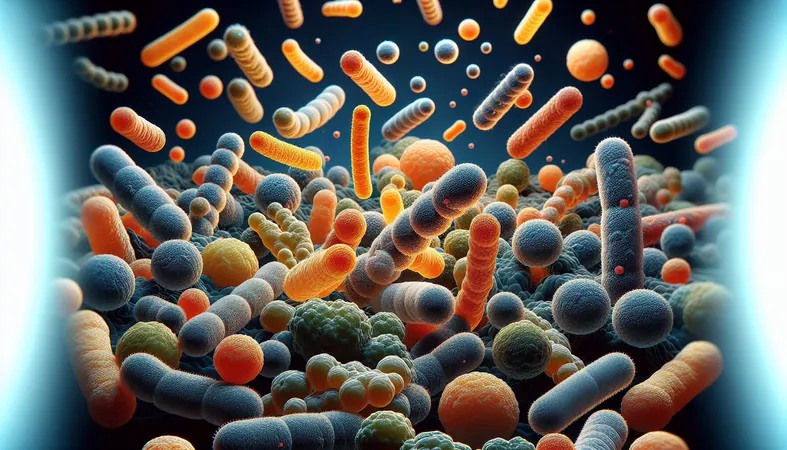
Fascinating Discovery: How Gut Bacteria Wage War with Gene Transfer!
2024-10-24
Author: Arjun
Fascinating Discovery: How Gut Bacteria Wage War with Gene Transfer!
New discoveries from the University of Chicago have revealed an intriguing battle taking place in the human gut: gut bacteria evolve rapidly by sharing genetic elements, affecting their ability to compete with one another. A study highlights how Bacteroides fragilis, a dominant species of bacteria in our intestines, acquires a mobile genetic element that transforms its weaponry system, showing how the microscopic world is rife with warfare and adaptation.
Bacteroides fragilis typically uses a deadly mechanism known as the Type VI secretion system (T6SS) to target and eliminate competitor bacteria. This system injects toxins into neighboring cells with jaw-dropping precision, akin to a poison-tipped spear. However, a recent study has shown that when B. fragilis acquires a large mobile genetic fragment, it effectively disables its primary T6SS weapon while gaining a different offensive capability. This highlights the complex strategies bacteria employ to survive in a competitive environment.
Laurie Comstock, Ph.D., a microbiologist at UChicago and the study's senior author, has focused her research on the mechanisms by which these bacteria transfer DNA for over a decade. Her findings signal a profound understanding of how gene transfer can drastically reshape bacterial interactions and the balance of power within our gut microbiome.
Unpacking the Genetic Warfare
The research demonstrated that the introduction of a mobile genetic element known as the GA1 integrative and conjugative element (ICE) modified B. fragilis's previously effective T6SS. Initially, scientists noted that some strains of B. fragilis ceased to use their GA3 T6SS capabilities after acquiring the GA1 ICE. They further affirmed this by transferring the GA1 ICE into strains already armed with GA3 T6SS and observing the new strains' inability to launch attacks with their original weapons.
The implications of this genetic exchange extend beyond mere survival; they influence the dynamics of entire bacterial communities within the gut. The study revealed that in a controlled experiment using germ-free mice, the GA1 ICE-transformed B. fragilis outcompeted its original strains, ushering in a new player in the ecosystem.
A Shift in Strategy: Defense Becomes Offense
The most riveting discovery from Comstock’s study was that the GA3 T6SS was hardly produced in the gut environment. Remarkably, a gene carried on the GA1 ICE acted as a transcriptional repressor, shutting down the production of the GA3 system altogether. This defense mechanism allows the GA1 ICE strains to thrive while eliminating the threats posed by their previously dominant counterparts.
From an ecological standpoint, this shift means that once Bacteroides strains acquire the GA1 ICE, they can evade attacks from classic B. fragilis strains, effectively turning the tables in this microscopic combat scenario. The acquired GA1 T6SS enables them to launch a defensive perimeter against other Bacteroidales invaders, fostering a dynamic balance among gut residents.
Future Research and Therapeutic Implications
Comstock's ongoing research aims to delve deeper into the mysterious world of transcriptional repressors carried on mobile genetic elements. Understanding how these elements interact and influence bacterial behavior could have substantial implications for developing synthetic bacterial consortia aimed at therapeutic applications.
"With the potential of gene transfer in play, it is crucial for scientists developing bacterial therapies to consider safeguards against introducing detrimental gene exchanges," Comstock emphasizes.
The findings underline a complex and intricate web of interactions within our gut microbiome, revealing that tiny organisms are capable of remarkable adaptations that intertwined with human health. As this research unfolds, it could reshape our understanding of gut health, potentially leading to advanced treatments for various gastrointestinal diseases and other health complications. Stay tuned—there's much more to uncover in the hidden world of gut bacteria!

 Brasil (PT)
Brasil (PT)
 Canada (EN)
Canada (EN)
 Chile (ES)
Chile (ES)
 España (ES)
España (ES)
 France (FR)
France (FR)
 Hong Kong (EN)
Hong Kong (EN)
 Italia (IT)
Italia (IT)
 日本 (JA)
日本 (JA)
 Magyarország (HU)
Magyarország (HU)
 Norge (NO)
Norge (NO)
 Polska (PL)
Polska (PL)
 Schweiz (DE)
Schweiz (DE)
 Singapore (EN)
Singapore (EN)
 Sverige (SV)
Sverige (SV)
 Suomi (FI)
Suomi (FI)
 Türkiye (TR)
Türkiye (TR)